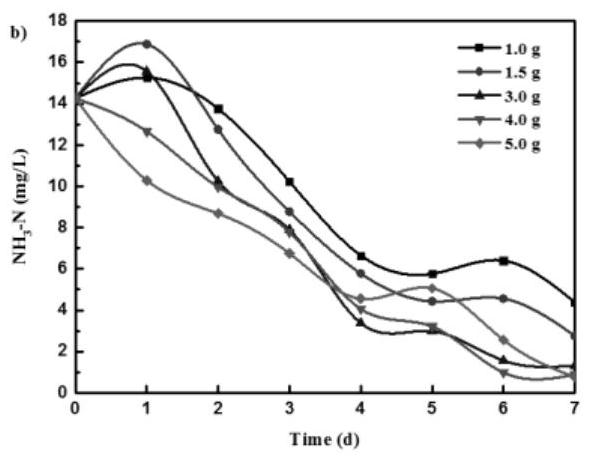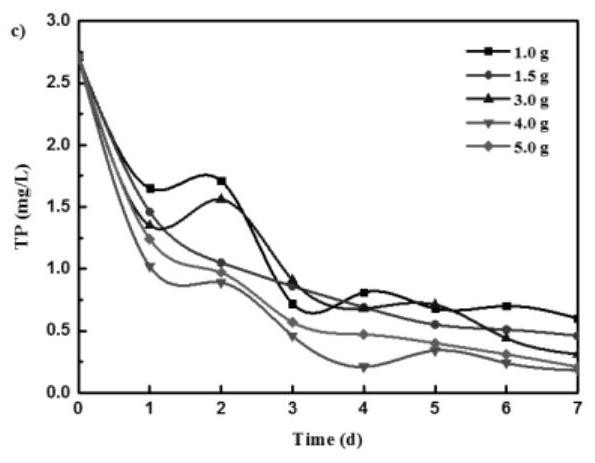Method for treating black and odorous water by photocatalysis coupled microbial technology
A microbial technology, black and odorous water technology, applied in special compound water treatment, sustainable biological treatment, biological water/sewage treatment, etc., can solve the problems of difficult popularization and application, secondary pollution, serious situation, etc. Effect
- Summary
- Abstract
- Description
- Claims
- Application Information
AI Technical Summary
Problems solved by technology
Method used
Image
Examples
preparation example Construction
[0047] The preparation method of described nutrient solution is:
[0048] Each 1L culture solution is prepared by mixing the following raw materials in the weight ratio: 192mg NaAc·3H2O, 70mg NH4Cl, 12mg K2HPO4·3H2O, 11mg NaH2PO4·2H2O, 2mg CaCl2 / L, 2mg MgSO4·7H2O, and the rest is water.
[0049] The chemical oxygen demand COD of black smelly water described in the example Gr 132.6–148.6mg / L, ammonia nitrogen NH 3 -N was 14.26–15.75 mg / L and total phosphorus TP was 2.71–2.85 mg / L.
Embodiment 1
[0051] Place an aeration tray at the bottom of a 500mL beaker, add 400mL of black and odorous water, take 1.0g, 1.5g, 3.0g, 4.0g, 5.0g of microbial loads and domesticated bagasse cellulose-titanium dioxide composite carriers in the beaker, adjust The pH is 7, then put it into the photocatalytic reaction box and 10cm away from the 25W ultraviolet light source, turn on the aeration (air aeration, the flow rate is 2L / min), turn on the light source at the same time, start timing, respectively at 0d, 1d, 2d , 3d, 4d, 5d, 6d, 7d take water samples to measure COD, NH3-N, TP concentration. The result is shown in Figure 1.
[0052] This embodiment lasted 7 days from the beginning to the end of the reaction. With the increase of the carrier dosage, the removal effect of COD, NH3-N and TP in the black odorous water became better and better. The removal effect was the best when the carrier dosage reached 4g. When the value exceeds the optimal value, the removal effect gradually stabilize...
Embodiment 2
[0054] Place an aeration tray at the bottom of a 500mL beaker, add 400mL of black and odorous water, take 4.0g of microbial load and domesticated bagasse cellulose-titanium dioxide composite carrier, put it in the beaker, adjust the pH to 7, and put it into the photocatalytic reaction box At 10cm from the ultraviolet light source, the light sources are 8W, 15W, and 25W respectively. Turn on the aeration (air aeration, the flow rate is 2L / min), turn on the light source, and start timing. , 7d to take water samples to measure COD, NH3-N, TP concentration. The result is shown in Figure 2.
[0055] In this embodiment, from the beginning to the end of the reaction, as the light intensity of the light source increases, the removal effect of black and odorous water becomes better and better (as shown in Figure 2).
PUM
 Login to View More
Login to View More Abstract
Description
Claims
Application Information
 Login to View More
Login to View More - R&D
- Intellectual Property
- Life Sciences
- Materials
- Tech Scout
- Unparalleled Data Quality
- Higher Quality Content
- 60% Fewer Hallucinations
Browse by: Latest US Patents, China's latest patents, Technical Efficacy Thesaurus, Application Domain, Technology Topic, Popular Technical Reports.
© 2025 PatSnap. All rights reserved.Legal|Privacy policy|Modern Slavery Act Transparency Statement|Sitemap|About US| Contact US: help@patsnap.com



